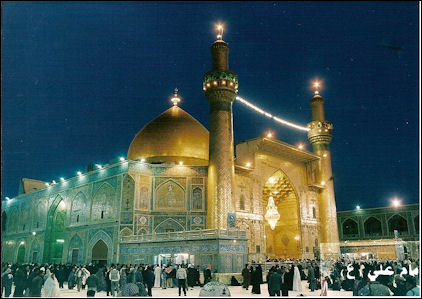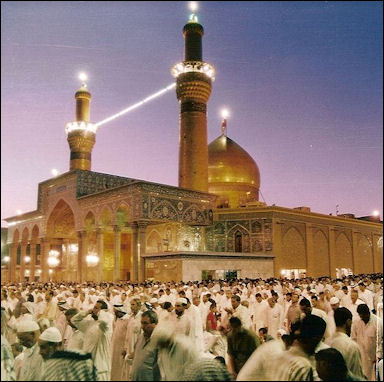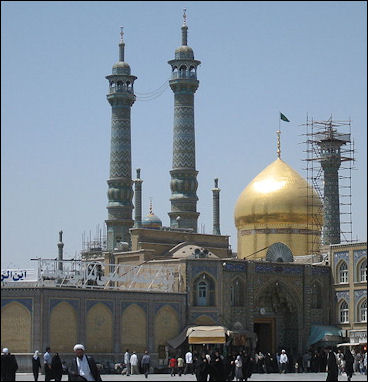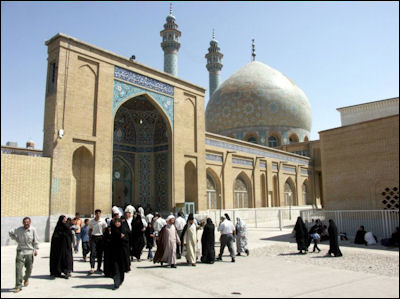SHIA HOLY SITES AND PILGRIMAGES

Kaaba in Mecca
John L. Esposito wrote in the “Worldmark Encyclopedia of Religious Practices”: In Shiism the family of Ali and the imams became objects of imitation and veneration. Sites associated with their lives or deaths became mosques and shrines, the objects of veneration and pilgrimage. Shrines and holy cities such as Najaf (the burial place of Ali) and Karbala (the site of the martyrdom of Hussein), both in Iraq, or Mashhad and Qum, in Iran, became centers for learning and pilgrimage where rituals of commemoration, prayer, and celebration were performed. In Sunni Islam places associated with the Prophet Muhammad, his family, and companions, as well as with later martyrs and Sufi saints, became shrines and centers of pilgrimage and places for prayer, petitions, blessings, and miracles. [Source: John L. Esposito “Worldmark Encyclopedia of Religious Practices”, 2000s, Encyclopedia.com]
The two holiest sites in Shia Islam after Mecca and Medina are the Imam Ali Mosque in Najaf and the Imam Husayn shrine in Karbala. A significant practice of Shia Islam is that of visiting the shrines of Imams in Iraq and in Iran. In Iraq, these include the tomb of Imam Ali in An Najaf and that of his son, Imam Husayn, in Karbala, because both are considered major Shia martyrs. Before the Iran-Iraq War (1980-88), tens of thousands made the visits each year. Other principal pilgrimage sites in Iraq are the tombs of the Seventh Imam and the Ninth Imam at Kazimayn near Baghdad. In Iran, pilgrimage sites include the tomb of the Eighth Imam in Mashhad and that of his sister in Qom. Such pilgrimages originated in part from the difficulty and the expense of making the hajj to Mecca in the early days. [Source: Library of Congress *]
Pilgrimage to the shrines of Imams is a specific Shia custom. The most important shrines in Iran are those for the Eighth Imam in Mashhad and for his sister Fatima in Qom. There are also important secondary shrines for other relatives of the Eighth Iman in Rey, adjacent to south Tehran, and in Shiraz. In virtually all towns and in many villages there are numerous lesser shrines, known as imamzadehs, which commemorate descendants of the imams who are reputed to have led saintly lives. Shia pilgrims visit these sites because they believe that the imams and their relatives have power to intercede with God on behalf of petitioners. The shrines in Iraq at Karbala and An Najaf are also revered by Shia. [Source: Library of Congress, December 1987]
Websites on Shia Muslims (Shiites) Divisions in Islam archive.org ; Shi’a History and Identity shiism.wcfia.harvard.edu ; What is Shi'a Islam? iis.ac.uk ; History of Shi'ism: From the Advent of Islam up to the End of Minor Occultation al-islam.org ; Shafaqna: International Shia News Agency shafaqna.com ; Roshd.org, a Shia Website roshd.org/eng ; The Shiapedia, an online Shia encyclopedia web.archive.org ; Imam Al-Khoei Foundation (Twelver) al-khoei.org ; Official Website of Nizari Ismaili (Ismaili) the.ismaili ; Official Website of Alavi Bohra (Ismaili) alavibohra.org ; The Institute of Ismaili Studies (Ismaili) web.archive.org ; Four Sunni Schools of Thought masud.co.uk
Najaf
Najaf (100 miles south Baghdad) is a major Shia pilgrimage center and a center of Shia scholarship. Founded by the caliph Harun ar-Rashid in A.D. 791 and home to around 500,000 people, it is where the Ali shrine is located. The shrine is said to contain the tomb of Ali, the Prophet Muhammad’s cousin and son-in-law, and a patriarch of Shia Islam. For Shia this shrine makes Najaf the third holiest place after Mecca and Medina and the holiest Shia site.
Najaf traditionally has been the home of most important Shia madrasahs (religious schools). But when Saddam Hussein cracked down on Shia in Iraq and Ayatollah Khomeini created a religious state in Iran, it was displaced by Qom in Iran as the spiritual capital of Shia Islam and the main center of Shia scholarship. Since Saddam’s demise Najaf has regained some of its former stature.

Imam Ali Mosque in NajafIman Ali Shrine is built around Ali’s gold-encrusted tomb. The dome is overlaid with 7,777 solid gold plates that "shine like a second sun." The tomb chamber is adorned cut-glass mirror mosaics and polished silver grillwork. The holy mosque was badly damaged in the Shia uprising against Saddam Hussein after the first Persian Gulf War. Non-Muslims are generally not allowed to enter unless they have special permission.
Many Shia bring deceased loved ones to Najaf to be buried the same Hindus bring their dead to the Ganges for cremations. During the Shia funerals, season, corpses wrapped in red carpets are brought in on the roofs of taxis and carried in processions around Ali’s elegant tomb or shrine. Many are buried in Najaf's Valley of Peace, a huge sacred cemetery. There are many other cemeteries in Najaf. Many of the graves are small shrines. One Iraqi told the Washington Post, “For us Shia, going to the shrine was like going to your home. You could rest in the courtyard. You could sit and read. You could go with friends You could observe the pilgrims from all over.”
One person e-mailed me, saying he didn’t like linking Najaf burial customs with the Hindu practice of bringing their dead to the Ganges for cremations. He said: “The practice of bringing the death to Najaf is for placing them in the valley of peace in Najaf. This practice is around the muslim world. At one point before the Wahhabi/Salafi era of Saudi Arabia, People would bury there love ones in Jannuel Baqee in Medina. This practice is very much seldom done because in the Wahhabi ideology, it is considered grave worshiping. I would prefer that the act of burying ones dead in Najaf not be placed as Hindus taking their dead to the Ganges. Islam is a Monotheism faith and both Shia and Sunni faith believe that. Comparing them on the same level is not respectful to either religion.”
Karbala

Imam Husayn Mosque in Karbala Karbala (70 miles south of Baghdad) is another major pilgrimage center for Shia, who regard it as the forth holiest place after Mecca, Medina and Najaf. Hussein and Abbas, grandsons of the Prophet Muhammad and sons of Ali, are buried is two shrines here. They were both killed here in A.D. 680 in the Battle of Karbala, one of the defining moments of Muslim and Shia history.
Karbala is located 100 kilometers (60 miles) southwest of Baghdad and 80 kilometers (45 miles) north of Najaf. After Hussain’s death, a tomb was soon built in Karbala which attracted devotees and benefactors. Over the years, Hussain’s shrine was destroyed, rebuilt, remodeled and expanded.[Source :Edith Szanto, Assistant Professor of Religious Studies, University of Alabama, The Conversation, September 9, 2020]
In Karbala there are two shrine-mosques — one for Hussein and one for his half brother Abbas — with golden domes and minarets, blue tile work and massive cedar doors. They stand a few hundred yards apart across a large courtyard. Their tombs are enclosed in ornate silver cages and sit below gilded copper domes. As is the case with Najaf, the shrines draw pilgrims from all over the world and many Shia bring dead relatives to Karbala for funerals and burial. Hundreds of thousands of pilgrims visit the shrines every year. Some come from Iran. During the bloody festivals held in Karbala thousand whip themselves.
See Battle of Karabala Under HISTORY OF SUNNI-SHIA DIVISIONS africame.factsanddetails.com ; See Arbeen Under SHIA (SHIITE) FESTIVALS, PILGRIMAGES AND SPECIAL DAYS factsanddetails.com
Samarra
In Iraq, Askariya Shine in Samarra is regarded as the third holiest Shia shrine after the mosques in Najaf and Karbala. Known for its golden dome and respected as a symbol of sacrifice and martyrdom, it is said to have been built near the place where the al-Mahdi, the last of the 12 great imams, disappeared. Al-Mahdi was the son and grandson of the two revered Shia imams — Ali al-Hadi and Hasan al-Askira (the “Hidden Imam”) who are buried in the shrine. The shrine is a popular Shia pilgrimage destination. It was badly damaged in an al-Qaeda bomb attack in February 2006 that triggered a nasty wave of sectarian violence between Sunnis and Shia.

Al Askari Mosque
Under the Abbasid Caliphs, Samarra was the capital the Muslim world. The Great Mosque of Samarra was once the largest mosque in the world. It is only a ruin now but at one time it had a wooden roof, supported by 464 columns that covered an area equal to one and hand football field. When Samarra was capital of the Muslim world, descendants of the Prophet Muhammad, Ali and Hasan lived under house arrest and allegedly were poisoned at the military camp of the Sunni caliph, al Mutsasim.
One question that some people have is what attracted people to Samarra, which is in the middle of the desert, in the first place. The answer seems to be: hunting. The Persian Sassanid kings used to come to hunt to from the 3rd to the 7th century. Four large hunting reserves were set up with gazelles, wild donkeys and other animals brought in for the kings to kill. Caliph al Multaism Ali liked to hunt.
Sunnis and Shia joined hands to rebuild it Askariya Shine. In June 2007 militants again infiltrated Askariya Shine and blew apart the minarets.
Shia Shrines In Iran
Shrines are major religious institutions in Iran. There are more than 1,100 shrines that vary from crumbling sites associated with local saints to the imposing shrines of Imam Reza and his sister Fatima in Mashhad and Qom, respectively. These more famous shrines are huge complexes that include the mausoleums of the venerated Eighth Imam and his sister, tombs of former shahs, mosques, madrasehs, and libraries. Imam Reza's shrine is the largest and is considered to be the holiest. In addition to the usual shrine accoutrements, Imam Reza's shrine contains hospitals, dispensaries, a museum, and several mosques located in a series of courtyards surrounding his tomb. Most of the present shrine dates from the early fourteenth century, except for the dome, which was rebuilt after being damaged in an earthquake in 1673. The shrine's endowments and gifts are the largest of all religious institutions in the country. Traditionally, free meals for as many as 1,000 people per day are provided at the shrine. Although there are no special times for visiting this or other shrines, it is customary for pilgrimage traffic to be heaviest during Shia holy periods. It has been estimated that more than 3 million pilgrims visit the shrine annually. [Source: Library of Congress, December 1987 *]

Masoumeh in Mashhad Visitors to Imam Reza's shrine represent all socioeconomic levels. Whereas piety is a motivation for many, others come to seek the spiritual grace or general good fortune that a visit to the shrine is believed to ensure. Commonly a pilgrimage is undertaken to petition Imam Reza to act as an intermediary between the pilgrim and God. Since the nineteenth century, it has been customary among the bazaar class and members of the lower classes to recognize those who have made a pilgrimage to Mashhad by prefixing their names with the title mashti.*
The next most important shrine is that of Imam Reza's sister, Fatima, known as Hazarat-e Masumeh (the Pure Saint). The present shrine dates from the early sixteenth century, although some later additions, including the gilded tiles, were affixed in the early nineteenth century. Other important shrines are those of Shah Abdol Azim, a relative of Imam Reza, who is entombed at Rey, near Tehran, and Shah Cheragh, a brother of Imam Reza, who is buried in Shiraz. A leading shrine honoring a person not belonging to the family of Imams is that of the Sufi master Sayyid Nimatollah Vali near Kerman. Shia make pilgrimages to these shrines and the hundreds of local imamzadehs to petition the saints to grant them special favors or to help them through a period of troubles.*
Because Shia believe that the holy Imams can intercede for the dead as well as for the living, cemeteries traditionally have been located adjacent to the most important shrines in both Iran and Iraq. Corpses were transported overland for burial in Karbala in southern Iraq until the practice was prohibited in the 1930s. Corpses are still shipped to Mashhad and Qom for burial in the shrine cemeteries of these cities.*
The constant movement of pilgrims from all over Iran to Mashhad and Qom has helped bind together a linguistically heterogeneous population. Pilgrims serve as major sources of information about conditions in different parts of the country and thus help to mitigate the parochialism of the regions.*
Mashad
Mashhad (near the border with Turkmenistan and Afghanistan) is regarded by many as Iran’s holiest place. Mashhad means “Place of Martyrdom.” It is so named because Iman Reza, the Eighth Imam and only one of the 12 Shia Iman buried in Iran, is buried here. He died in nearby village in A.D. 817 after, legend has it, he was poisoned (more likely he got sick after eating spoiled grapes some scholars say). Today Mashhad is a major pilgrimage center. Shia from Iran and all over the world come here to pay their respects to the great imam.
The Shrine of Iman Reza (in Mashhad) is the holiest shrine and most important pilgrimage center in Iran. It consists of a sanctuary with a magnificent gilded dome, resting over Iman Reza’s tomb. The chambers are covered by glazed tiles and shining mirrors and are filled with pilgrims praying and reciting passages from the Qur’an. The main pilgrimage season is during No Ruz in June to mid-July. Some pilgrims have walked here from Isfahan as Shah Abbas I (1571-1629) did before he commissioned the shrine to be built.

Imam Reza Shrine
Mashad, close to the border with Afghanistan, was given a boost as a pilgrimage site by Shah Abbas, who ruled the Persians Empire from 588-1629. He once walked barefoot from Isfahan to the shrine of Imam Reza in Mashad, a distance of several hundred kilometres, to enhance the prestige of the shrine as a place of Shia pilgrimage in part because the Ottomans controlled the most important Shia pilgrimage sites at Najaf and Kerbala in what is now Iraq. [Source: Madeleine Bunting, The Guardian, January 31, 2009 /=/]
Madeleine Bunting wrote in The Guardian: “Today Mashad is one of the biggest pilgrimage sites in the world, with 20 million visitors every year. In peak season, hundreds of buses arrive each day, and there are 24 daily flights from Tehran alone; passengers at the airport are greeted with a huge slogan above the arrivals gate, in Iranian and English: "Welcome pilgrim to pray to Imam Reza as an intercessor before God."/=/
“To cope with the volume of pilgrims, huge motorways and underground car parks have been built around the shrine complex. More are planned as this small city of seminaries, libraries, museums and conference centres continues to grow; cranes jostle alongside the minarets. It is also a major business centre - the shrine owns factories, hospitals and agricultural enterprises. Since the Islamic revolution in 1979, money has been poured into the expansion of the shrine much as it was by Abbas in a bid to build legitimacy for his rule more than 400 years ago. /=/
“Mashad's precincts teem with people from every social background, from large peasant families of several generations to the stylish young Tehrani couples who come here on honeymoon. All the women must be in full black chador, and attendants with bright pink and yellow feather dusters are everywhere to ensure that even the smallest lock of hair is hidden. Every pilgrim wants to touch the shrine of Imam Reza; such is the crush around the golden grille that often it is only possible to get close to it late in the evening or at night. /=/
“The shrine's vast museum is subjected to the same veneration. The pilgrims touch the doorjamb of the entrance and brush their lips in prayer; many exhibits prompt more touching and praying - donations are left at some. This is a museum unlike any other in the world: a place of worship. The museum's collections are made up entirely of gifts, and the abundance is bewildering: there's a model of Mashad airport, and then the medals of the great Iranian wrestler of the 20th century, Gholamreza Takhti. There is even a lifesize lobster in gold donated by the Supreme Ayatollah. And interspersed among four centuries' worth of giving are the gifts of Abbas, including some beautiful early Qur'ans. /=/
Qom

QomQom (90 miles south of Tehran) is Iran’s second holiest city but is No. 1 in religious power based on importance of its religious schools and its religious authority. The Ayatollah Khomeini was trained at the madrasahs and theological schools here and lived here when he returned from exile in 1979. The current leader of Iran, Ayatollah Khameni, and many of the religious leaders who rule the country lives here rather than in Tehran.
Kim Murphy wrote in the Los Angeles Times:“This has always been a city with one foot in the present and two in the medieval past. A walk down its dusty main boulevard threads through epochs. Fast food chelo kebab stands and souvenir shops, with wallet-size portraits of the 7th century martyr Imam Hussein, crowd outside the colossal gold and blue domes of the Hazrat Masumeh shrine. Mullahs in turbans pick their way defiantly through tangled ribbons of cars. Here, in a city that is the revered seat of Iran's powerful Shia Muslim clergy and home to 52 Islamic seminaries, women in black chadors emerge from late-model Mercedes-Benzes with tinted windows. [Source: Kim Murphy, Los Angeles Times, April 7, 2007]
Qom owes its importance to the presence of shrine covering the tomb of Hazzrat Masoumeh, the sister of Imam Reza, the 8th Shia Imam. A popular pilgrimage site, the shrine is a gaudy structure that dominates the Qom skyline. Its dome and minarets are similar in shape to those on the Taj Mahal. The shrine was built by the Safavids and covered with gold tiles by the Qajar Shah Fath-Ali. Non-Muslims are usually not welcome.
Qom has been the center of revolutionary Islam in Iran for a long time. It is known as the “city of blood and revolt” because of an uprising that occurred here in June 1962. It tripled in size after the Islamic revolution in 1979 and is now home to nearly a million people and has surpassed Najaf, Iraq as the world’s center of Shia scholarship.
Modern Qom is a place where the 7th and 21st centuries meet. Among the mosques and seminaries with golden domes and turquoise-and-green mosaic tiles, men are in clerical robes and turbans ride bicycles and motorbikes. Almost all women you see wear chadors. Computer centers bring the Qur’an to the Internet and CD-Roms. Bookstores offer little other than religious texts. Some bookstores specialize in a single scholar. The Faizeh Theological School is where the Ayatollah Khomeini studied. It has a large quadrangle, seminaries and classrooms, where you can see students chanting verses and memorizing passages of the Qur’an. Some 30,000 students live in Qom. Many live in dormitories and survive on stipends of $30 a month. Thousands of scholars have spent the better part of their lives here, studying Islamic texts, laws and sciences or preparing to be mullahs and religious leaders. The ayatollah and other high-level clerics operate out of small offices on narrow alleyways.
Qom Enters the Internet Age in the 2000s
Reporting from Qom, Kim Murphy wrote in the Los Angeles Times: Here, stocking-footed men sit behind rows of computer screens in large rooms padded with deep Oriental carpets, typing out Web pages of Qur’anic analysis and religious edicts translated into 30 languages. From here, via a server in Santa Clara, Calif., emanates www.al-shia.com, the most widely read source of Shia proselytizing in the world. Also here is the worldwide communications hub for Grand Ayatollah Ali Sistani, Iraq's leading Shia cleric, www.sistani.org, and for Iran's supreme leader, Ayatollah Ali Khamenei, www.leader.ir. [Source: Kim Murphy, Los Angeles Times, April 7, 2007 /=]

Hazarat-e Masumeh
“For years, many of Iran's clerics resisted a new age's preference for video screens over ancient Qur’anic calligraphy. They sanctioned the removal of satellite dishes from rooftops, called for website filtering to guard against pornography and peered at the nation's budding blogging craze as if it were a bizarre insect that would require new poisons. ("Blogging, due to its mundane nature, has the capacity to nurture the spirit of vulgarity ... [and is] a destructive plague," Sayed Reza Shokrollahi wrote a few years ago.) /=\
“Then they got it. Now, to browse through Iranian websites is to come upon a flood of pages featuring solemn-looking men wearing beards and turbans. Hundreds of Iranian clerics today have blogs of their own. "Qom province is ranked first in Iran in terms of the ratio of population and Internet facilities," said Ibrahim Lajevardi, the cleric who heads the Aalulbayt. "In every bazaar and alley, you will find the Internet. This is because Qom is one of the most religious cities in Iran, and it was decided to have access to the Internet in order to spread this Islamic knowledge all over the world." /=\
Qom's religious leaders hope to build new links between the mother ship and the world's 150 million Shia Muslims. But moving Shiism to the Internet is also part of a wider government campaign to rebuild Iran as a geopolitical and technological powerhouse in the Middle East.
Here in these halls filled with the sound of clicking keyboards, websites are produced for Grand Ayatollah Muhammad Hussein Fadlallah, Hezbollah's spiritual oracle in Lebanon (www.bayynat.org), and 42 other ayatollahs. The clerics provide advice on religious questions. ("Is it allowed to employ non-Muslims in my office?" Yes, but better to hire Muslims if you can. "Is it permissible to be party to temporary marriage with a woman who is 'known for adultery,' if no other woman is available and the person is in desperate need of marriage?" Not unless she repents.) Other offices in Qom stray toward politics; some sites deliver the Shia orthodoxy's views on everything from relations with Sunni Muslims to the role of the United Nations, the "Holocaust myth" and condemnations of the U.S. campaign in Iraq.” /=\
Image Sources: Wikimedia Commons
Text Sources: Internet Islamic History Sourcebook: sourcebooks.fordham.edu ; Arab News, Jeddah; “Islam, a Short History” by Karen Armstrong; “A History of the Arab Peoples” by Albert Hourani (Faber and Faber, 1991); “World Religions” edited by Geoffrey Parrinder (Facts on File Publications, New York); “Encyclopedia of the World’s Religions” edited by R.C. Zaehner (Barnes & Noble Books, 1959); Metropolitan Museum of Art, Encyclopedia.com, National Geographic, BBC, New York Times, Washington Post, Los Angeles Times, Smithsonian magazine, The Guardian, Al Jazeera, The New Yorker, Time, Newsweek, Reuters, Associated Press, AFP, Library of Congress and various books and other publications.
Last updated April 2024
